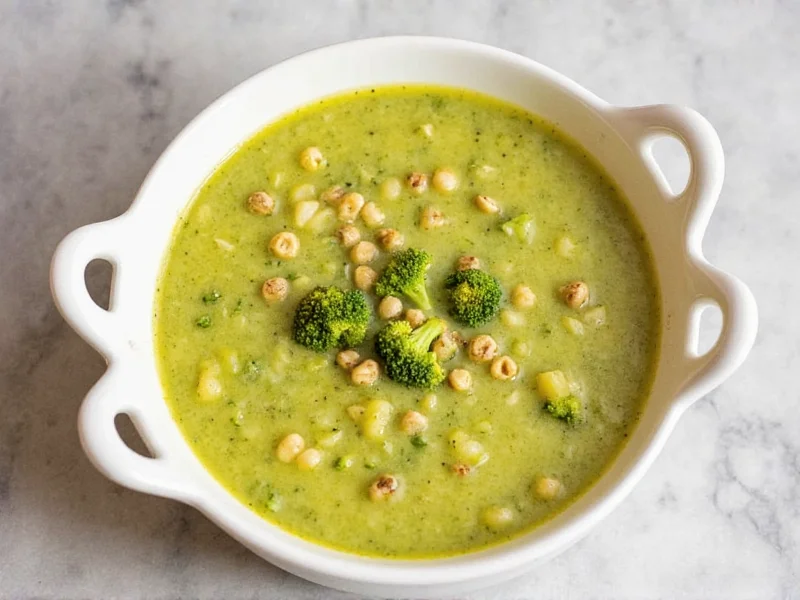The Ultimate Baked Broccoli Casserole: A Comfort Food Classic
Broccoli casserole stands as a beloved American comfort food that transforms simple ingredients into a rich, satisfying side dish. What distinguishes a proper casserole from soup? The answer lies in texture and structure. While soup remains liquid throughout, a true casserole sets during baking, creating a cohesive yet tender dish that holds its shape when served. This baked preparation method creates layers of flavor and texture impossible in soup-based preparations.
Why This Recipe Works
Many "broccoli casserole" recipes online actually describe soups or casseroles made with canned soup as a base. This authentic version builds flavor from scratch using real ingredients. The secret to perfect texture lies in properly cooking the broccoli to retain some bite while creating a velvety cheese sauce that sets firmly when cooled. The golden breadcrumb topping provides essential textural contrast that soup-based versions lack entirely.
Essential Ingredients for Authentic Flavor
Quality ingredients make the difference between an ordinary side dish and an extraordinary one. Here's what you'll need for the best homemade broccoli casserole without soup:
| Ingredient | Quantity | Why It Matters |
|---|---|---|
| Fresh broccoli florets | 4 cups | Provides better texture and brighter flavor than frozen |
| Sharp cheddar cheese | 2 cups shredded | Creates rich flavor foundation (avoid pre-shredded for best melt) |
| Butter | 4 tablespoons | Essential for proper roux base (don't substitute oil) |
| All-purpose flour | 1/4 cup | Thickens sauce without altering flavor like canned soup would |
| Whole milk | 1 1/2 cups | Creates creamy texture (lower fat milk makes sauce break) |
| Panko breadcrumbs | 1/2 cup | Provides superior crunch compared to cracker toppings |
Step-by-Step Preparation Guide
Follow these precise steps for a perfect broccoli casserole that maintains its structure and delivers balanced flavors:
- Prepare the broccoli: Blanch fresh broccoli florets in boiling salted water for 2 minutes, then immediately plunge into ice water. Drain thoroughly and spread on paper towels to remove excess moisture. Properly dried broccoli prevents a watery casserole.
- Create the cheese sauce: Melt butter in a saucepan over medium heat. Whisk in flour to form a roux, cooking for 2 minutes until golden. Gradually add milk while whisking constantly. Cook until thickened (about 5 minutes), then remove from heat and stir in cheese until smooth. Season with 1/2 teaspoon garlic powder, 1/4 teaspoon onion powder, and white pepper to taste.
- Combine ingredients: In a large bowl, gently fold the drained broccoli into the cheese sauce. Transfer to a greased 9x13 inch baking dish.
- Add the topping: Mix panko breadcrumbs with 2 tablespoons melted butter and 1/4 cup grated parmesan. Sprinkle evenly over the casserole.
- Bake to perfection: Bake at 375°F for 25-30 minutes until the topping is golden brown and the casserole is bubbling around the edges. Let rest for 10 minutes before serving to allow the sauce to set properly.
Common Variations and Substitutions
This versatile recipe adapts well to different preferences while maintaining its essential casserole character:
- Protein boost: Add 1 cup cooked, diced chicken breast for a main dish version (add after combining broccoli and sauce)
- Dairy-free option: Substitute coconut milk for dairy milk and nutritional yeast for cheese (note: texture will be slightly different)
- Gluten-free adaptation: Use rice flour instead of wheat flour and gluten-free breadcrumbs
- Vegetable variation: Replace 1 cup broccoli with cauliflower florets for added complexity
Troubleshooting Common Issues
Even experienced cooks encounter challenges with casseroles. Here's how to solve frequent problems:
- Watery casserole: This happens when broccoli isn't properly dried or sauce isn't thick enough. Solution: Increase roux cooking time by 1 minute and ensure broccoli is thoroughly drained.
- Dry texture: Overbaking or insufficient sauce causes this. Solution: Check casserole at 20 minutes and cover with foil if top browns too quickly.
- Sauce separation: Using low-fat dairy or pre-shredded cheese often causes this. Solution: Stick to whole milk and freshly grated cheese.
- Soggy topping: Moisture from the casserole softens the topping. Solution: Add topping during the last 10 minutes of baking.
Serving and Storage Recommendations
For best results, serve broccoli casserole hot but not piping hot—allowing it to rest for 10 minutes after baking lets the sauce set properly. This dish pairs perfectly with roasted chicken, baked ham, or as part of a holiday spread. Leftovers store well in an airtight container in the refrigerator for up to 4 days. Reheat individual portions in the oven at 325°F for 15-20 minutes (microwaving makes the topping soggy). Freeze unbaked casseroles for up to 3 months—thaw in the refrigerator overnight before baking.
Why This Isn't Soup (And Why That Matters)
The fundamental difference between a proper broccoli casserole and soup comes down to structure and purpose. Soup remains liquid, served in bowls with a spoon. A casserole sets during baking, creating a dish that can be sliced and served on a plate alongside other meal components. The ratio of solid to liquid ingredients is crucial—this recipe maintains a 3:1 solid-to-liquid ratio, while soup-based versions typically reverse this. Understanding this distinction ensures you create an authentic casserole that delivers the comforting, substantial experience expected of this classic dish.











 浙公网安备
33010002000092号
浙公网安备
33010002000092号 浙B2-20120091-4
浙B2-20120091-4